Penion
Penion is a genus of large marine snails, commonly known as siphon whelks, classified within the mollusc family Buccinidae, the true whelks.[4][5][6]
| Penion | |
|---|---|
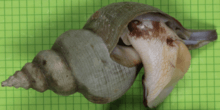 | |
| A siphon whelk Penion cuvierianus jeakingsi, collected from Golden Bay in New Zealand | |
| Scientific classification | |
| Kingdom: | |
| Phylum: | |
| Class: | |
| (unranked): | |
| Superfamily: | |
| Family: | |
| Genus: | Penion P. Fischer, 1884[1] |
| Species | |
|
See text | |
| Synonyms | |
Description
Siphon whelks are large, benthic marine snails, or whelks.[6][7][8][9][10]
Penion are commonly called siphon whelks because they have a very long siphon. Species typically have a large, pointed operculum.[11] Radulae have 3 or 4 cusps on lateral teeth and 3 cusps on central teeth.[11]
Males have a long, dorso-ventrally flattened penis, and correspondingly females have a large pallial oviduct and albumen gland.[11] However, geometric morphometric investigation of P. chathamensis indicates that secondary sexual dimorphism is not prominent for shell shape or size.[9]
Shells of Penion vary significantly in shape, size and colouration, making the distinction of species difficult.[8][9][10][11] Shells are fusiform with a tall spire of roughly equal height to the aperture and siphonal canal combined.[11] Protoconch morphology is also highly variable, from 1.5 - 4.0 whorls in height.[11] The siphonal canal of the shell is often long to protect the elongated siphon.[11] Small shells (or fossils) can be confused with those of Aeneator or Antarctoneptunea.[10][12]
Ecology
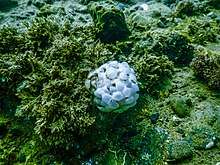
Most species occur in deep water,[9][10] and inhabit soft sediments on the continental shelf.[13]
All species of Penion have a wide ranging diet, and are detritivores and carnivores that actively hunt prey.[8][9] P. sulcatus is known to feed on mussels and Dosina zelandica zelandica.[8][14] Members of the genus have similar niche placement to species of Buccinum in the Northern Hemisphere.
Distribution
Penion species are restricted to the Southern Hemisphere.[9] Two extant species are currently classified in waters surrounding Australia[11] and six extant species are documented from New Zealand.[5][7][10]
Numerous fossil species are recorded in New Zealand,[12] Australia,[11] Argentina and Chile,[15][16] and Antarctica.[17][18][19] In New Zealand, many fossils are found in Wanganui Basin sediments.[12]
During the voyage of HMS Beagle, fossils of P. subrectus were among palaeontological samples collected by Charles Darwin from the mouth of the Santa Cruz River in Argentina.[20]
Evolution
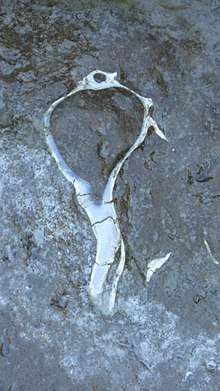
Penion is currently classified within Buccinidae, the family of true whelks.[5][21] Alternatively they have been referred to the family of Buccinulidae.[5][21]
| ||||||||||||||||||||||||
| Cladogram for Penion and related genera.[5][10][21] |
Molecular phylogenetic trees based on mitochondrial genomic and nuclear ribosomal DNA sequence data indicate that Penion is closely related to two genera: Kelletia found in the north Pacific Ocean and Antarctoneptunea, distributed in waters surrounding New Zealand and Antarctica.[5][10][21] Radulae and opercula morphology is similar between Penion and Kelletia.[11] It is possible that the earliest known fossils of Penion belonging to P. proavitus from the New Zealand Paleocene (Teurian), actually represent a stem lineage that was the common ancestor of these three genera.[5]
In Australian waters, the sister species P. mandarinus and P. maximus have overlapping geographic ranges (sympatry), and may have evolved from a common ancestor via niche differentiation based on prey size and water depth.[10]
Human use
Penion shells are prized by shell collectors.
Shells found in middens of historic Māori settlements indicate that P. sulcatus may have been intentionally foraged as a food-source.[22][23]
Species
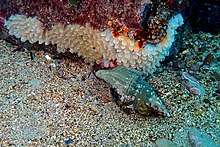
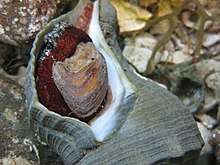
Species and subspecies in the genus Penion include:
- † Penion affixus (Finlay, 1930)[12]
- † Penion asper (Marwick, 1928)[12]
- † Penion australocapax Stilwell & Zinsmeister, 1992[17][18][19]
- † Penion bartrumi (Laws, 1941)[12]
- † Penion brazieri (Fleming, 1955)[12]
- Penion chathamensis (Powell, 1938)[21]
- † Penion clifdenensis (Finlay, 1930)[12]
- † Penion crassus Frassinetti, 2000[15]
- † Penion crawfordi (Hutton, 1873)[12]
- Penion cuvierianus (Powell, 1927)[7][12][24]
- Penion cuvierianus jeakingsi (Powell, 1947)[7]
- † Penion darwinianus (Philippi, 1887)
- † Penion diversum Frassinetti, 2000[15]
- † Penion domeykoanus (Philippi, 1887)[11]
- † Penion exoptatus (Powell & Bartrum, 1929)[12]
- Penion fairfieldae (Powell, 1947)[7][12]
- † Penion finlayi (Laws, 1930)[12]
- † Penion gauli (Marwick, 1928)[12]
- † Penion haweraensis (Powell, 1931)[12]
- † Penion hiatulus (Powell, 1947)[12]
- † Penion huttoni (L.R. King, 1934)[12]
- † Penion imperfectus (Powell, 1947)[12]
- † Penion interjunctus (Finlay, 1930)[12]
- † Penion koruahinensis (Powell & Bartrum, 1928)[12]
- Penion lineatus Marshall, Hills & Vaux, 2018[6][10]
- † Penion longirostris (Tate, 1888)[11]
- † Penion macsporrani (Philippi, 1887)
- Penion mandarinus (Duclos, P.L., 1831)[11]
- † Penion marwicki (Finlay, 1930)[12]
- Penion maximus (Tryon, G.W., 1881)[11]
- † Penion oncodes (Philippi, 1887)
- Penion ormesi (Powell, 1927)
- † Penion parans (Finlay, 1930)[12]
- † Penion patagonensis Reichler, 2010[16]
- † Penion petitianus (d'Orbigny, 1842)
- † Penion proavitus (Finlay & Marwick, 1937)[12]
- † Penion roblini (Tenison Woods, 1876)[11]
- † Penion spatiosus (Tate, 1888)[11]
- † Penion subrectus (Ihering, 1899)[11][20]
- † Penion subreflexus (G.B. Sowerby I, 1846)[11]
- † Penion subregularis (d'Orbigny, 1852)
- Penion sulcatus (Lamarck, 1816)[7][12][21]
- † Penion winthropi (Marwick, 1965)[12]
Nomina dubia
Beu 2009 lists the following Antarctic fossil species as nomina dubia:
- † Penion antarctocarinatus (Stilwell & Zinsmeister, 1992),[17] potentially Antarctoneptunea[18]
- † Penion gazdzicki (Karczewski, 1987), previously Neptunea and Beringius, potentially Antarctoneptunea[18]
Species brought into synonymy
- Penion adustus (Philippi, 1845): synonym of Penion sulcatus (Lamarck, 1816)[24]
- Penion dilatatus (Quoy & Gaimard, 1833): synonym of Penion sulcatus (Lamarck, 1816)[24]
Reclassified species
- Penion benthicolus Dell, 1956: accepted as Antarctoneptunea benthicola (Dell, 1956)[5]
References
- Fischer, P. 1884. Manuel de Conchyliologie et de Paléontologie Conchyliologique ou histoire naturelle des mollusques vivant et fossiles. Paris: F. Savy Vol. 7 pp. 609-688.
- Iredale, T. 1924. Results from Roy Bell's molluscan collections. Proceedings of the Linnean Society of New South Wales 49(3): 179-279, pls 33-36.
- Iredale, T. 1914. On some invalid molluscan generic names. Proceedings of the Malacological Society of London 11: 170-178.
- Vaux, Felix (2017). Evolutionary lineages and the diversity of New Zealand true whelks (Doctor of Philosophy thesis). Massey University. hdl:10179/13113.
- Vaux, Felix; Hills, Simon F.K.; Marshall, Bruce A.; Trewick, Steven A.; Morgan-Richards, Mary (2017). "A phylogeny of Southern Hemisphere whelks (Gastropoda: Buccinulidae) and concordance with the fossil record". Molecular Phylogenetics and Evolution. 114 (2017): 367–381. doi:10.1016/j.ympev.2017.06.018. PMID 28669812.
- Marshall, Bruce A.; Hills, Simon F.K.; Vaux, Felix (2018). "A new species of Penion P. Fischer, 1884 from northern New Zealand (Mollusca: Neogastropoda: Buccinoidea)". Molluscan Research. 38 (4): 238–242. doi:10.1080/13235818.2017.1420398.
- Powell A. W. B., New Zealand Mollusca, William Collins Publishers Ltd, Auckland, New Zealand 1979 ISBN 0-00-216906-1
- Willan, R.C., de C. Cook, S., Spencer, H.G., Creese, R.G., O’Shea, S., Jackson, G.D. Phylum Mollusca. In: de C. Cook, S.C. (eds.), New Zealand Coastal Marine Invertebrates 1, 406 – 407. Canterbury University Press, Christchurch, New Zealand ISBN 978-1877257-60-5
- Vaux, Felix; Crampton, James S.; Marshall, Bruce A.; Trewick, Steven A.; Morgan-Richards, Mary (2017). "Geometric morphometric analysis reveals that the shells of male and female siphon whelks Penion chathamensis are the same size and shape". Molluscan Research. 37 (3): 194–201. doi:10.1080/13235818.2017.1279474.
- Vaux, Felix; Crampton, James S.C.; Trewick, Steven A.; Marshall, Bruce A.; Beu, Alan G.; Hills, Simon F.K.; Morgan-Richards, Mary (2018). "Evolutionary lineages of marine snails identified using molecular phylogenetics and geometric morphometric analysis of shells". Molecular Phylogenetics and Evolution. 127 (October 2018): 626–637. doi:10.1016/j.ympev.2018.06.009. PMID 29913310.
- Ponder, W.F.. 1973. A review of the Australian species of Penion Fischer (Neogastropoda: Buccinidae). Journal of the Malacological Society of Australia 2: 401–428.
- Beu, Alan G.; Maxwell, P.A. (1990). "Cenozoic Mollusca of New Zealand". New Zealand Geological Survey Paleontological Bulletin. New Zealand Geological Survey Bulletin. Lower Hutt, New Zealand: New Zealand Department of Scientific and Industrial Research. 58. ISSN 0114-2283.
- Dell, R.K.. 1962. New Zealand Marine Provinces - do they exist? Tuatara, 10: 43 - 52. Online Copy courtesy of New Zealand Electronic Text Collection
- Wilson, B. 1994. Australian Marine Shells. Prosobranch Gastropods. Kallaroo, WA : Odyssey Publishing Vol. 2 370 pp.
- Frassinetti, Daniel (2000). "Upper Pliocene marine molluscks from Guafo Island, southern Chile. Part II. Gastropoda". Boletin del Museo Nacional de Historia Natural, Chile. 49: 131–161.
- Reichler, Valeria A. (2017). "Estratigrafía y paleontología del Cenozoico marino del Gran Bajo y Salinas del Gualicho, Argentina y descripción de 17 especies nuevas". Andean Geology. 37 (1): 177–219. doi:10.4067/S0718-71062010000100008.
- Stilwell, J.D., Zinsmeister, W.J. 1992. Molluscan systematics and biostratigraphy, lower Tertiary La Meseta Formation, Seymour Island, Antarctic Peninsula. American Geophysical Union Antarctica Research Series 55: 126-128. DOI: 10.1029/AR055 ISBN 9781118667705
- Beu, Alan G. (2009). "Before the ice: Biogeography of Antarctic Paleogene molluscan faunas". Palaeogeography, Palaeoclimatology, Palaeoecology. 284 (3–4): 191–226. doi:10.1016/j.palaeo.2009.09.025.
- Crame, J. Alistair; Beu, Alan G.; Ineson, Jon R.; Francis, Jane E.; Whittle, Rowan J.; Bowman, Vanessa C. (2014). "The Early Origin of the Antarctic Marine Fauna and Its Evolutionary Implications". PLOS One. 9 (12): e114743. doi:10.1371/journal.pone.0114743. PMC 4262473. PMID 25493546.
- Parras, Ana; Miguel, Griffin (2009). "Darwin's great Patagonian Tertiary formation at the mouth of the Río Santa Cruz: a reappraisal". Revista de la Asociación Geológica Argentina. 64 (1): 70–82.
- Hayashi, Seiji (2005). "The molecular phylogeny of the Buccinidae (Caenogastropoda: Neogastropoda) as inferred from the complete mitochondrial 16s rRNA gene sequences of selected representatives". Molluscan Research. 25: 85–98.
- Green, R.C.; Pullar, W.A. (1960). "Excavations at Orongo Bay, Gisborne". The Journal of the Polynesian Society. 69 (4): 332–353.
- Allen, Melinda S. (2012). "Molluscan foraging efficiency and patterns of mobility amongst foraging agriculturalists: a case study from northern New Zealand". Journal of Archaeological Science. 39 (2012): 295–307. doi:10.1016/j.jas.2011.09.013.
- Ponder, W.F.. 1975. Identity of Penion dilatatus (Quoy & Gaimard, 1833) (Mollusca: Buccinidae). New Zealand Journal of Marine and Freshwater Research 9 (4): 569-571..
External links
| Wikimedia Commons has media related to Penion. |
- Museum of New Zealand Te Papa Tongarewa, Taxon: Penion (Genus)
- Auckland War Memorial Museum: Penion specimens
- Revised descriptions of New Zealand Cenozoic Mollusca from Beu and Maxwell (1990)
- Checklist of the Recent Mollusca Recorded from the New Zealand Exclusive Economic Zone
- Molluscs of Tasmania: Buccinidae - Siphonaliinae: Genus Penion Fischer, 1884 - “whelks”
Further reading
- Powell A. W. B., New Zealand Mollusca, William Collins Publishers Ltd, Auckland, New Zealand 1979 ISBN 0-00-216906-1